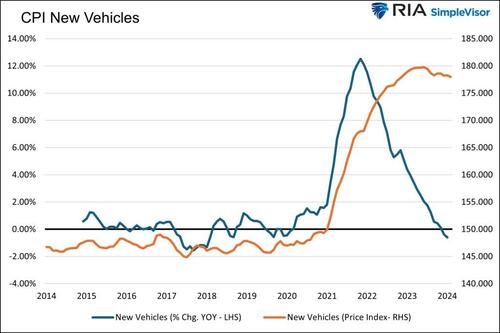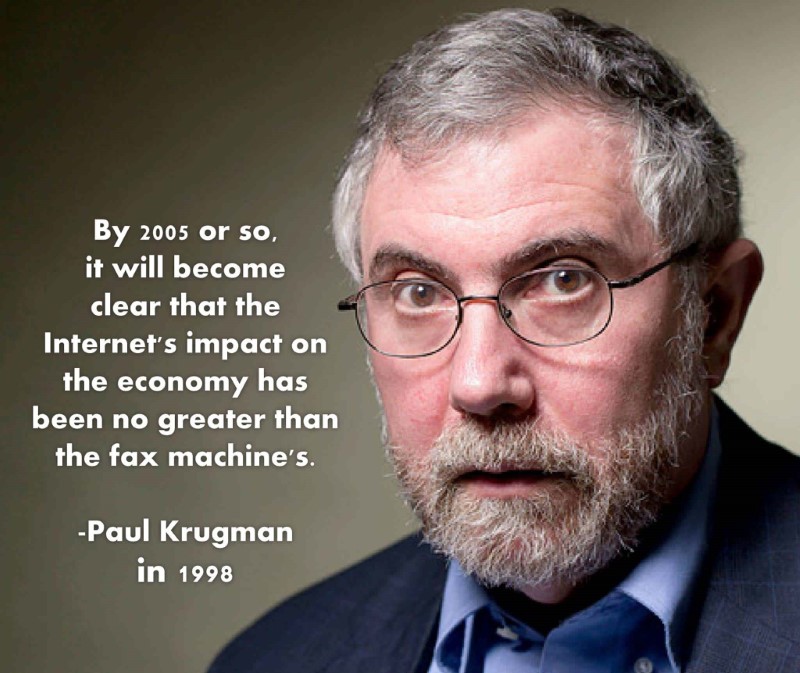
Posted on 06/26/2024 10:47:24 AM PDT by SeekAndFind
The Fed and economists are encouraged because CPI is down to 3.3% from a high of nearly 9% in 2022. Despite the Fed’s “significant progress” in lowering inflation, most citizens are outraged and confused by economists’ relatively rosy inflation observations. Most citizens believe inflation is still rampant.
The Fed and economists are correct in that inflation is now tame. At the same time, citizens dissatisfied with high prices have solid grounds on which to base their disapproval.
Let’s better understand how such contradictory beliefs can both be factual. Furthermore, in the process, we can help Jerome Powell understand why economic sentiment is poor despite a near-record low unemployment rate.
"You know, I don’t think anyone knows, has a definitive answer why people are not as happy about the economy as they might be."
-Jerome Powell 6/12/2024
The graph below of the BLS CPI New Vehicles price index, a CPI component, demonstrates why economists and citizens have such grossly contrasting opinions of inflation.
Economists focus on the blue line, graphing the year-over-year change in new vehicle prices. Over the last year, the price index of new vehicles has decreased by .60%. Economists can say the cost of buying a new vehicle is in a deflationary state.
While the chart may warm the hearts of economists and the Fed, most individuals see the orange line, the CPI price index for new vehicles instead. It shows that new vehicle prices are up about 20% since the pandemic. Yes, they may have recently declined slightly, but today’s prices are nowhere close to where they were four years ago. In their minds, there is significant inflation in new vehicles.
Ask an economist what the nation’s GDP is, and they will quote an annualized growth rate to a decimal point. We bet almost all of them will get the answer correct within one or two-tenths of one percent.
Ask them again, but request the answer in dollars. It would not be surprising if many economists are off by a trillion or even two trillion dollars, representing anywhere from 3.00% to 7.00% of the economy.
Economists prefer to analyze and quote many economic data points in terms of percentage change. For instance, how much did industrial production or retail sales change versus last month or over the previous quarter or year? They vastly prefer growth rates because it gives them a comparable and insightful way of analyzing economic data. Let’s review why this is the case.
Economists are more adept at comparing data from different periods, industries, and countries if they have a common measurement calculation. Instead of absolute change, which doesn’t account for the starting point, a growth rate captures the absolute change and the starting point. Consider the following:
If GDP increases by $1 trillion this year, how would that compare to a $1 trillion increase in 2000? The question is challenging to answer using absolute numbers. However, growth rates allow us to evaluate the two periods quickly. Today, GDP is $28.284 trillion; therefore, a $1 trillion increase would represent 3.50% growth. In 2000, GDP was close to $10 trillion. Adding a trillion dollars of economic growth would have resulted in a 10% growth rate. While a trillion dollars is a trillion dollars in absolute terms, there is a stark difference between 10% and 3.50% growth.
Growth rates highlight trends and changes over time more clearly than absolute numbers. They can show whether an economy is accelerating, decelerating, or maintaining a steady pace.
Consider the graph below. The blue line, showing the make-believe production of widgets, starts at 1,000 widgets and increases by 100 widgets annually. The steady growth in absolute terms is a linear upward trending line. However, the annual growth rate steadily declines from 10% to 4% by year 20. An economist looking at the graph would say the rate of the production of widgets is declining despite the upward trend in the number of widgets being produced annually.
The Fed aims to promote stable economic growth. To do so they balance the level of interest rates with inflation and economic activity. Having like figures to analyze, such as growth rates, makes their task significantly more straightforward. Imagine if the Fed had to determine the appropriate interest rate given that the economy grew by $750 billion last year and the CPI price index rose by 2.45.
Investors prefer growth rates for the same reason. If I can estimate the economy’s growth rate and other critical economic figures, they can better determine a growth rate or interest rate they would accept for taking risks.
The capital asset pricing model (CAPM) is a bedrock for finance. The formula states that an asset’s expected return should equal the risk-free interest rate plus the asset’s sensitivity (beta) times the market’s expected return. This formula can only work with growth rates, not absolute numbers.
Regarding inflation, consumers are less concerned with growth rates and heavily focused on absolute prices. They remember that bread used to cost $4 a loaf and now costs $7. The graph below shows the price of white bread was stable between $1.25 and $1.50 a pound from 2008 to the pandemic. It is now close to $2 a pound.
That is significant inflation. But it doesn’t tell the whole story. If wages also rose similarly, purchasing power hasn’t changed. It is similar to hearing stories from your parents or grandparents about going to the movies and getting popcorn and a soda, all for $1. Did you ever ask them how much money they made at the time?
We want to make it clear that we do not condone inflation. It accelerates an already wide wealth gap and creates hardships for many citizens. For more, please read our article, Fed Policies Turn The Wealth Gap Into A Chasm.
We analyze inflation data similarly to economists. We accept that absolute prices are much higher today than a few years ago, but we also acknowledge that, in general, wages are higher as well. Just like we can’t realistically compare a 15-cent McDonald’s hamburger to a $3.00 one today, we should be careful comparing prices today to their prices a few years ago.
Prices are not returning to 2020 levels. In fact, any hint that aggregate prices retreat from current levels will cause the Fed to panic and quickly stimulate inflation via lower interest rates and QE. We remind you that the Fed was lamenting that we didn’t have enough inflation throughout most of the period between the financial crisis and the pandemic.
because econometricians (aka “economists”) are full of it.
That’s because the economists are lying as they are paid to do.
That’s because the economists are lying as they are paid to do.
“That’s because the economists are lying as they are paid to do.”
Exactly my first thought. No elaborate math necessary to understand what’s going on - just stop gaslighting.
Because the economists don’t focus on what consumers actually buy. Cutting the price of caviar by half, because demand has collapsed, is not going to relevant to the consumer or Musk’s consumer trips to space being cut in half.
If you focus commonly buy, it’s a different story.
So, let this straight...
Economists are abstract, take the long-term view and are smart, while consumers are stupid, oblivious to making more money in wages and listen to old Grandpa stories?
Dudes, if you’re not making much, having to pay even a few cents more can really matter. Even the smaller increases in the price of food can bring up survival angst. Show some empathy.
Inflation has gone down a lot through disinflation. It’s gone from about 9.3% to about 3% annually. That’s a lot.
The problem is that people think “inflation going down” means prices should be going down below where they were before the latest round of inflation started. But all inflation is upward movement in prices, even tiny inflation. Inflation at 3% means prices are rising at an annual rate of 3%. This is historically normal.
People think they should get deflation, which they will only get if we have a deep recession or depression. The govt’s insistence on using the FED reserve to try to avoid recessions (which are normal and necessary) leads to deeper recessions so people will eventually get their wish but they won’t like that any better.
This isn’t going to change because the present setup allows politicians to overspend and rake off graft for themselves, families and donors and they aren’t giving that up. Citizens keep electing the same crooks so they will continue to get the same results until they learn to elect people in business. Govt is the biggest business in America, and businessmen and women should be running it.
cuz the 3.3 is a made up number
They continue to change how the CPI is calculated, and miraculously, every change causes the CPI to b lower.
It reminds me of the old book “How to Lie with Statistics”.
Most economists are govt stooges. Economics, as it is taught, is plain nonsense. Want to wreck your business? Employ an economist.
Take a look at items tracked that were removed: food, gas, etc.
The problem is that economists can say the inflation rate is coming down (in certain measures).
However, that does not change, or represent, the CUMULATIVE AFFECT of inflation since Biden took office which is X% on top of X% on top of X% quarter by quarter. That cumulative affect, and it’s result in prices, is significantly more than the “this quarter” inflation rate at present.
Some economists are not necessarily wrong but the proper focus should be on cumulative inflation; that’s what people are feeling.
No, it’s an estimate, which is all that can be expected. An estimate that’s closer than what people simply make up.
Define “ down”.
Down from whare? What baseline?
Idiots.
I use how much I have to pay for sh*t as an indicator of inflation. Using a calculator is a real dumbass Nobel way of doing it.
I don’t think “economists” include food and gasoline in their calculations.
Because civilians just notice inflating, not really the rate. For our bank accounts things getting more expensive are just more expensive. Less more expensive than last year doesn’t really mean anything for us.
I just had a Whopper meal. $12
In CA probably quite more.
The biggest problem is that the food, fast food restaurants, hotels, gas and electricity went up the most.
Poor people do not buy gizmos and fancy stuff, which actually did not go up that much.
So Biden policies are hurting the poor people the most!
Pretty much due to his so called green policies and wasteful spending.
good example of the different realities of nobel prize winning economists:

Disclaimer: Opinions posted on Free Republic are those of the individual posters and do not necessarily represent the opinion of Free Republic or its management. All materials posted herein are protected by copyright law and the exemption for fair use of copyrighted works.